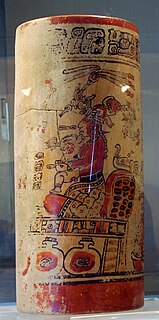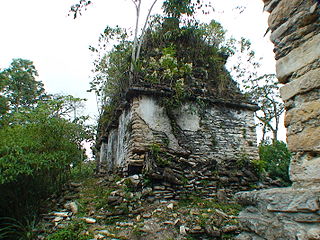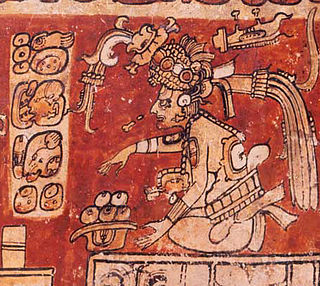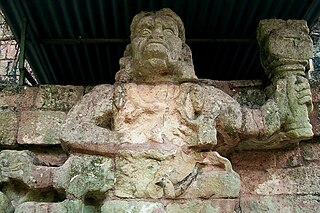
Copán is an archaeological site of the Maya civilization in the Copán Department of western Honduras, not far from the border with Guatemala. It was the capital city of a major Classic period kingdom from the 5th to 9th centuries AD. The city was in the extreme southeast of the Mesoamerican cultural region, on the frontier with the Isthmo-Colombian cultural region, and was almost surrounded by non-Maya peoples.

Yaxchilan is an ancient Maya city located on the bank of the Usumacinta River in the state of Chiapas, Mexico. In the Late Classic Period Yaxchilan was one of the most powerful Maya states along the course of the Usumacinta River, with Piedras Negras as its major rival. Architectural styles in subordinate sites in the Usumacinta region demonstrate clear differences that mark a clear boundary between the two kingdoms.

Kʼinich Janaab Pakal I (Mayan pronunciation: [kʼihniʧ xanaːɓ pakal], also known as Pacal, Pacal the Great, 8 Ahau and Sun Shield, was ajaw of the Maya city-state of Palenque in the Late Classic period of pre-Columbian Mesoamerican chronology. He acceded to the throne in July 615 and ruled until his death. During a reign of 68 years, the longest known regnal period in the history of the Americas, the 30th longest worldwide and longest until Frederick III in the 15th century, Pakal was responsible for the construction or extension of some of Palenque's most notable surviving inscriptions and monumental architecture.
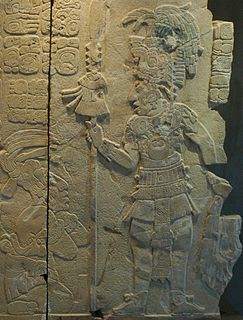
Kʼinich Kan Bahlam II, also known as Chan Bahlum II, was ajaw of the Maya city-state of Palenque. He acceded to the throne in January, 684, several months after the death of his father and predecessor, Kʼinich Janaab Pakal I and ruled until his death.

Tonina is a pre-Columbian archaeological site and ruined city of the Maya civilization located in what is now the Mexican state of Chiapas, some 13 km (8.1 mi) east of the town of Ocosingo.

Kʼinich Ahkal Moʼ Nahb III also known as Chaacal III and Akul Anab III,, was an ajaw of the Maya city of Palenque. He took the throne on 30 December 721, reigning until c.736.
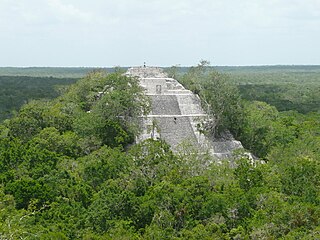
Calakmul is a Maya archaeological site in the Mexican state of Campeche, deep in the jungles of the greater Petén Basin region. It is 35 kilometres (22 mi) from the Guatemalan border. Calakmul was one of the largest and most powerful ancient cities ever uncovered in the Maya lowlands.
Itzam Kʼan Ahk I, also known as Ruler 2, was an ajaw of Piedras Negras, an ancient Maya settlement in Guatemala. He ruled during the Late Classic Period, from AD 639-686. The son of Kʼinich Yoʼnal Ahk I, Itzam Kʼan Ahk I took the throne when he was only 12 years old. His reign was marked by several wars, and he seems to have had a special connection with Calakmul. Itzam Kʼan Ahk I died just a few days before the marriage of his son, who succeeded him as ajaw of Piedras Negras and took on the name Kʼinich Yoʼnal Ahk II. Itzam Kʼan Ahk I left behind several monuments, including eight stelae stelae, three panels, a throne, and a short stela-like column; this made him the most active of Piedras Negras's leaders in regards to erecting monuments.

Yikʼin Chan Kʼawiil also known as Ruler B, Yaxkin Caan Chac and Sun Sky Rain,, was an ajaw of the Maya city of Tikal. He took the throne on December 8, 734.

Chak Tok Ichʼaak I also known as Great Paw, Great Jaguar Paw, and Toh Chak Ichʼak was an ajaw of the Maya city of Tikal. He took the throne on August 7, 360? and reigned until his death in 378, apparently at the hands of invaders from central Mexico.

During the 7th and 8th centuries in Mesoamerica, there was an evident shift in the roles women played in ancient Maya society as compared with the previous two centuries. It was during this time that there was a great deal of political complexity seen both in Maya royal houses as well as in the Maya area. Warfare was a significant factor in political competition and marriage was one of the ways that alliances were made between the different polities. This was accompanied by a shift in women's roles from wife and mother to playing integral parts in courtly life, such as participating in rituals involving the supernatural world and at times ruling individual polities.

Sihyaj Chan Kʼawiil II, also known as Storm Sky and Manikin Cleft Sky, was an ajaw of the Maya city of Tikal. He took the throne on November 26, 411 and reigned until his death. He was a son of his predecessor Yax Nuun Ahiin I and Lady Kʼinich, and a grandson of Spearthrower Owl. Stela 31, erected during his reign, describes the death of his grandfather in 439; other monuments associated with Sihyaj Chan Kʼawiil II are Stelae 1 and possibly Stelae 28. Tikal Temple 33 was Sihyaj Chan Kʼawiil II's funerary pyramid and his tomb was located beneath it.

Yat Ahk I was the third king of Mayan city-state Piedras Negras in Guatemala. He is also known as Ah Cauac Ah K'in, and by the English translation of his name, Turtle Tooth.

Kʼinich Yoʼnal Ahk II, also known as Ruler 3, was a king of Piedras Negras, Maya city in Guatemala. He reigned from January 2, 687 until 729.

Itzam Kʼan Ahk II, also known as Ruler 4, was an ajaw of Piedras Negras, an ancient Maya settlement in Guatemala. He ruled during the Late Classic Period, from 729–757 AD. Itzam Kʼan Ahk II ascended to the throne following the death of Kʼinich Yoʼnal Ahk II. Itzam Kʼan Ahk II may have fathered the following three kings of Piedras Negras: Yoʼnal Ahk III, Haʼ Kʼin Xook, and Kʼinich Yat Ahk II. Following Itzam Kʼan Ahk II's demise, he was succeeded by Yoʼnal Ahk III in 757 AD. Itzam Kʼan Ahk II left behind several monuments, including stelae at Piedras Negras and a large mortuary temple now known as Pyramid O-13. In addition, the details of his life and his Kʼatun-jubilee were commemorated on Panel 3, raised by Kʼinich Yat Ahk II several years following Itzam Kʼan Ahk II's death.

Yoʼnal Ahk III, also known as Ruler 5, was an ajaw of Piedras Negras, an ancient Maya settlement in Guatemala. He ruled during the Late Classic Period, from 758 to 767 AD. Yoʼnal Ahk III ascended to the throne upon the death of Itzam Kʼan Ahk II, who may have been Yoʼnal Ahk's father. He was succeeded by his probable brother, Haʼ Kʼin Xook in around 767 AD. Yoʼnal Ahk III left behind two surviving stelae at Piedras Negras, namely Stelae 14 and 16, the former of which has been called one of the finest niche stelae, according to Simon Martin and Nikolai Grube.
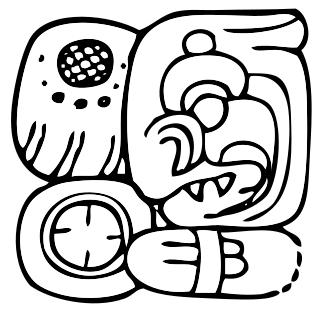
Haʼ Kʼin Xook, also known as Ruler 6, was an ajaw of Piedras Negras, an ancient Maya settlement in Guatemala. He ruled during the Late Classic Period, from 767–780 AD. Haʼ Kʼin Xook was a son of Itzam Kʼan Ahk II, and he ascended the throne following the death of his brother, Yoʼnal Ahk III. Haʼ Kʼin Xook's reign ended with either his death or his abdication in favor of his brother Kʼinich Yat Ahk II; archaeologists and Mayanists have not arrived at a clear consensus. Haʼ Kʼin Xook left behind several monuments, including stelae at Piedras Negras and a stone fragment from El Porvenir. In addition, a stone seat known as Throne 1 and erected by Kʼinich Yat Ahk II records either the death or abdication of Haʼ Kʼin Xook.

Kʼinich Yat Ahk II, also known as Ruler 7, was the last ajaw of Piedras Negras, an ancient Maya settlement in Guatemala. He ruled during the Late Classic Period, from 781 to roughly 808 AD. Possibly a descendant of Itzam Kʼan Ahk II, Kʼinich Yat Ahk II ascended the throne upon the death of his brother, the sixth ajaw of the site, Haʼ Kʼin Xook. While Kʼinich Yat Ahk II presided over the destruction of the rival Maya site Pomona, his reign likely ended with Kʼinich Tatbu Skull IV of Yaxchilan capturing and subjugating Piedras Negras. Itzam Kʼan Ahk II left behind several monuments, including stelae at Piedras Negras, a stone seat known as Throne 1 which records either the death or abdication of Haʼ Kʼin Xook, and Panel 3 which recounts the exploits of Itzam Kʼan Ahk II.
Parrot Chaak was a ruler of La Mar, an ancient Maya settlement in the Mexican state of Chiapas.






